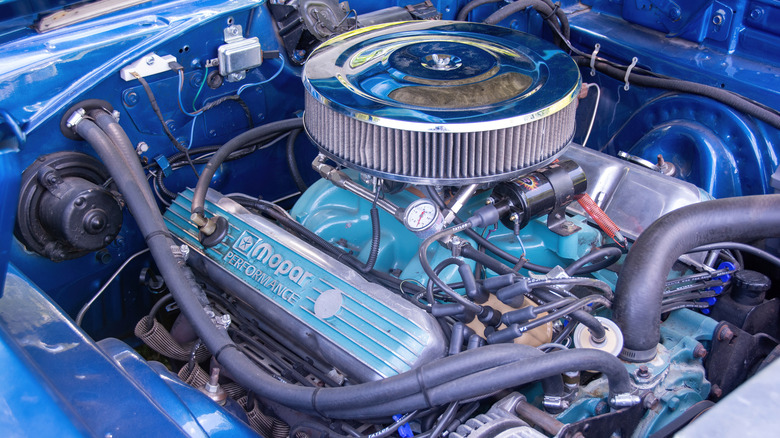
Straight off the bat, it's the engine sizes. The Mopar 383 V8 displaces 383 cubic inches (6.3 liters), sitting between the 340 (5.6 liters) and 440 (7.2 liters). The 340, 383, and 440 all are part of the Mopar V8 engine family and are among its greatest hits. But there are a lot of factors that help the Mopar 383 stand apart from the 340 and 440, especially in areas of engine architecture, performance, versatility, and reliability.
Also known as the Chrysler 383 Big Block, it followed the first-gen
Chrysler Hemi engines called the Firepower V8 engines. However, the 383 did not use a hemispherical combustion chamber. It used a wedge-type combustion chamber where the top (where the air-fuel mixture collects) is, well, wedged-shaped. While the wedge big block engines were introduced in 1958 with the B-Series 350 and 361, the 383 came out a year later. It essentially was a bored-out version of the 361, delivering 305 horsepower and 410 pound-feet of torque. Like other high-performance Chrysler V8s, the 383 was developed by Mopar, Chrysler's performance subsidiary. Mopar is a fascinating history lesson in itself.
Made from 1959 to 1971, the Mopar 383 was offered in the Chrysler 300, Newport, Town and Country, Saratoga, Windsor, and the DeSoto Adventurer. It came in the Dodge Super Bee, Charger, Dart, Challenger, Monaco, Coronet, and Polara, as well as D-series trucks and Custom 880s. And you could get it in the Plymouth Barracuda, Road Runner, Satellite, Belvedere, and Fury.
Read more: These Are The Most Forgettable Cars
The Big And Small Of It

Unlike the 383 and 440, the Mopar 340 is a small-block V8 first sold in 1968 as part of Chrysler's light A-series engine lineup. It addressed the need for a smaller, compact V8 engine for lighter vehicles. Claimed power was 275 horsepower and 340 lb-ft, though real-world tests put numbers at 320 hp and 368 lb-ft. By the time it was discontinued in 1973, the Mopar 340 was available in the Dodge Dart, Duster, Challenger, Charger, Super Bee, Swinger, and Demon as well as the Plymouth Barracuda, Road Runner, and Cuda.
The largest of the three, the Mopar 440 debuted in 1965, succeeding the Mopar 413. Unlike the 340 and 383, the Mopar 440 comes from Chrysler's Raised Block line of engines. It delivered 375 horsepower and 480 lb-ft. The Mopar 440 Big Block V8 was reserved for the high-performance versions of muscle cars like the Dodge Coronet R/T, Super Bee, Charger R/T, and Challenger R/T as well as the Plymouth Cuda, GTX, Superbird, and Road Runner.
In case it seems confusing, a lot of muscle cars came with different engine options, so some of those on the list share the Mopar 340, 383, and 440 power trains. We'd prefer them, too, even if the 2024 Dodge Charger Daytona EV is convincing muscle-car cosplay.
Key Differences Between The Mopar 383, 340, 440

Besides their engine sizes, these Mopar engines differed in power output. As mentioned, the 383 delivered 305 hp and 410 lb-ft; the 340 officially had 275 hp and 340 lb-ft; and the Mopar 440 pushed out 375 hp and 480 lb-ft. Chrysler even offered high-powered versions of these engines, offering them with exotic names. For example, the 383's high-performance versions were called the 383 Magnum, Commando, and Golden Commando. For the 340, it was the 340 Six-Pack and T/A (Trans Am). The Mopar 440 was also available in exotic trim like the 440 Magnum and 440 Six-Pack. But those are a thing of the past, and Dodge's gasoline-powered muscle cars are truly dead.
A major difference between the 383 and 340 was their intent. While the 383 Big Block V8 was meant for raw performance, the 340 Small Block V8 was designed to be lightweight and efficient.
When it comes to the 440 Big Block V8, a key difference with the 338 is its architecture, specifically their deck heights — the distance from the crankshaft centerline and top surface of the cylinder block (minus the cylinder head). The 383 has a low deck height of 9.98 inches, while the 440 has a raised deck height of 10.725 inches. Chrysler did make a 383 RB-Series with a raised deck matching the 440, but that was available just for two years, in 1959 and '60.
Want more like this? Join the Jalopnik newsletter to get the latest auto news sent straight to your inbox...
Read the original article on Jalopnik.












